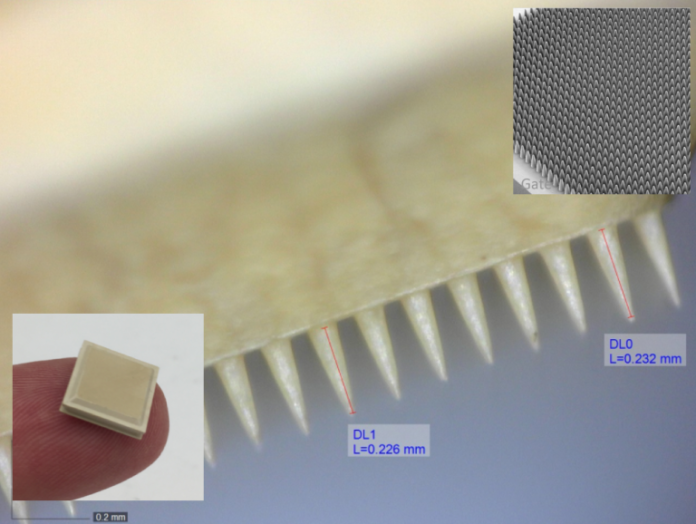On October 29, 2021, researchers from the University of Queensland, in Australia, published an article in the journal ScienceAdvances describing their invention of a high-density microarray patch (HD-MAP) to deliver COVID-19 vaccine directly through the skin. They noted that their patch “was superior to needle-and-syringe vaccination” because of the skin’s composition versus subcutaneous muscle the site of needle-delivered vaccinations. Our skin has an abundance of active immune cells. Muscles don’t. So when a vaccine interacts with skin it is likely to be more efficacious. And in addition, HD-MAPs provide easy and painless ways to deliver vaccines which can help to reduce vaccine hesitancy for those who are phobic about needles.
The vaccine being administered, using the HD-MAP technology, is called Vaxxas. In pre-clinical trials (mouse studies), it has shown excellent results when compared to vaccines by needle and syringe. Researchers have noted significantly enhanced T-cell and spike-specific antibody responses.
HD-MAP vaccine delivery systems consist of ultra-high-density arrays of tiny needle-like projections invisible to the human eye. They are bandage-sized and in the case of Vaxxas, packaged in foil and sealed in a small container. Vaxxas is stable at room temperature. It can be stored for 30 days at 25 Celsius (77 Fahrenheit) degrees, or for a week in temperatures as high as 40 Celsius (104 Fahrenheit). Compare that to Pfizer and Moderna which both require refrigeration not often easily available in many Developing World countries.
The ability to store the patches under normal room conditions makes them eminently suitable for use in medical offices, or even in future as self-administered alternatives to be used at home.
University of Queensland research fellow David A. Muller, who has been leading the study, in a June 2021 article appearing in Clinical Trials Arena states, “We designed this research to address the serious ongoing need to improve the global vaccination efforts against COVID-19 and future pandemics. Based on our results, we believe that Vaxxas’ HD-MAP could offer a compelling solution that importantly could use less vaccine and potentially could be readily distributed without refrigeration for self-administration…This combination could make the HD-MAP extremely well suited to support the massive need for global population vaccination and, indeed, we believe that HD-MAP offers a superior alternative to conventional needle-and-syringe.”
Vaxxas isn’t the only HD-MAP vaccine under development to address COVID-19. A company called Vaxess Technologies in Cambridge, Massachusetts has a similar vaccine delivery system under development. And a number of other universities are working on equivalents. The ones I have identified so far include the University of Pittsburgh, the University of California Davis, and Swansea University in Wales.
Vaccine patch technology has even gone 3D-printed. Work that is being done at Stanford University and the University of North Carolina at Chapel Hill has led to the creation of 3D-printed patches with the technology capable of being used for more than COVID-19. The micro-needles in patches can be coated with vaccine serum for other diseases.
As Joseph M. DeSimone, Professor of Translational Medicine at Stanford, and Professor Emeritus at Chapel Hill states, the technology can become the “foundation for even more rapid global development of vaccines, at lower doses, in a pain and anxiety-free manner.” He goes on, “One of the biggest issues we’ve learned during the pandemic is that innovation in science and technology can make or break a global response.” So it would seem that COVID-19 he concludes is “pushing the envelope for us all.”









